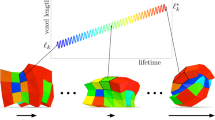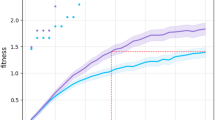Abstract
This paper presents a series of simulation experiments that incrementally extend previous work on neural robot controllers in a predator-prey scenario, in particular the work of Floreano and Nolfi, and integrates it with ideas from work on the ‘co-evolution’ of robot morphologies and control systems. The aim of these experiments has been to further systematically investigate the tradeoffs and interdependencies between morphological parameters and behavioral strategies through a series of predator-prey experiments in which increasingly many aspects are subject to self-organization through competitive co-evolution. Motivated by the fact that, despite the emphasis of the interdependence of brain, body and environment in much recent research, the environment has actually received relatively little attention, the last set of experiments lets robots/species actively adapt their environments to their own needs, rather than just adapting themselves to a given environment.
Similar content being viewed by others
Explore related subjects
Discover the latest articles, news and stories from top researchers in related subjects.References
R. Beckers, O. E. Holland, and J. L. Deneubourg, “From local actions to global tasks: Stigmergy and collective robotics,” in Artificial Life IV: Proceedings of the Fourth International Workshop on the Synthesis and Simulation of Living Systems, R. A. Brooks and P. Maes (Eds.), MIT Press: Cambridge, MA, 1994, pp. 181–189.
E. Bonabeau (Ed.) Stigmergy (special issue). Artificial Life, vol. 5, no. 2, 1999.
G. Buason, Competitive co-evolution of sensory-motor systems. Report HS-IDA-MD-02-004. Department of Computer Science, University of Skövde, Sweden, 2002a.
G. Buason, Competitive co-evolution of sensory-motor systems—Appendix. Report HS-IDA-TR-02-004. Department of Computer Science, University of Skövde, Sweden, 2002b.
G. Buason and T. Ziemke, “Competitive co-evolution of predator and prey sensory-motor systems,” in Applications of Evolutionary Computing—EvoWorkshops 2003, Cagnoni et al. (Eds.), Springer-Verlag: Berlin, pp. 605-615, 2003a.
G. Buason and T. Ziemke, “Co-evolving task-dependent visual morphologies in predator-prey experiments,” in Genetic and Evolutionary Computation Conference, Cantu-Paz et al. (eds.), Springer-Verlag: Berlin, pp. 458–469, 2003b.
G. Buason and T. Ziemke, “Exploration of task-dependent visual morphologies in competitive co-evolutionary experiments,” in Advances in Artificial Life Proceedings of the seventh European Conference on Artificial Life, W. Banzhaf, T. Christaller, P. Dittrich, J. T. Kim, and J. Ziegler (Eds.), Springer-Verlag: Berlin, pp. 763–770, 2003c.
J. Carlsson and T. Ziemke, “YAKS—Yet Another Khepera Simulator,” in Autonomous Minirobots for Research and Entertainment—Proceedings of the Fifth International Heinz Nixdorf Symposium, Rückert, Sitte and Witkowski (Eds.), HNI-Verlagsschriftenreihe: Paderborn, Germany, pp. 235–241, 2001.
H. J. Chiel and R. D. Beer, “The brain has a body: Adaptive behavior emerges from interactions of nervous system, body and environment,” Trends in Neurosciences, vol. 20 pp. 553–557, 1997.
A. Clark, Being There. MIT Press: Cambridge, MA, 1997.
D. Cliff and G. F. Miller, “Tracking the Red Queen: Measurements of adaptive progress in co-evolutionary simulations.” In Advances in Artificial Life—Proceedings of the Third European Conference on Artificial Life. F. Moran, A. Moreano, J. J. Merelo, and P. Chacon (Eds.), Springer-Verlag: Berlin, 1995.
D. Cliff and G. F. Miller, “Co-evolution of pursuit and evasion II: Simulation methods and results. in From Animals to Animats IV: Proceedings of the Fourth International Conference on Simulation of Adaptive Behavior, P. Maes, M. Mataric, J.-A. Meyer, J. Pollack, and S. W. Wilson (Eds.), MIT Press: Cambridge, MA, 1996, pp. 506–515.
D. Floreano and S. Nolfi, “God save the Red Queen! Competition in co-evolutionary robotics,” in Genetic Programming 1997: Proceedings of the Second Annual Conference, J. R. Koza, D. Kalyanmoy, M. Dorigo, D. B. Fogel, M. Garzon, H. Iba, and R. L. Riolo (Eds.), Morgan Kaufmann: San Francisco, CA, 1997a.
D. Floreano and S. Nolfi, “Adaptive behavior in competing co-evolving species,” in Advances in Artificial Life—Proceedings of the Fourth European Conference on Artificial Life, P. Husbands and I. Harvey (Eds.), MIT Press: Cambridge, MA, 1997b.
D. Floreano, S. Nolfi, and F. Mondada, “Competitive co-evolutionary robotics: From theory to practice,” in From Animals to Animats V: Proceedings of the Fifth International Conference on Simulation of Adaptive Behavior, R. Pfeifer, B. Blumberg, J.-A. Meyer, and S. W. Wilson (Eds.), MIT Press: Cambridge, MA, 1998.
P. Funes and J. Pollack, “Computer evolution of buildable objects,” in Advances in Artificial Life—Proceedings of the Fourth European conference on Artificial Life, P. Husbands and I. Harvey (Eds.), MIT Press: Cambridge, MA, 1997, pp. 358–367.
D. Kirsh, “Adapting the environment instead of oneself,” Adaptive Behavior, vol. 4, nos. 3/4, pp. 415-452, 1996.
W.-P. Lee, J. Hallam, and H. H. Lund, “A hybrid GP/GA approach for co-evolving controllers and robot bodies to achieve fitness-specified tasks,” in Proceedings of IEEE Third International Conference on Evolutionary Computation, IEEE International Conference on Evolutionary Computation (Ed.), IEEE Press: New York, 1996, pp. 384–389.
H. Lund, J. Hallam, and W. Lee, “Evolving robot morphology,” in Proceedings of IEEE Fourth International Conference on Evolutionary Computation, IEEE International Conference on Evolutionary Computation (Ed.), IEEE Press: New York, 1997, pp. 197–202.
S. Nolfi, “Evolutionary Robotics: Exploiting the full power of self-organization,” Connection Science, vol. 10, nos. 3/4, pp. 167–184, 1998.
S. Nolfi and D. Floreano, Co-evolving predator and prey robots: Do ‘arms races’ arise in artificial evolution? Artificial Life, vol. 4, pp. 311–335, 1998.
S. Nolfi and D. Floreano, Evolutionary Robotics: The Biology, Intelligence, and Technology of Self-Organizing Machines, MIT Press: Cambridge, MA, 2000.
S. Nolfi and D. Floreano, “Synthesis of autonomous robots through artificial evolution,” Trends in Cognitive Sciences, vol. 6, pp. 31–37, 2002.
R. Pfeifer and C. Scheier Understanding Intelligence. MIT Press: Cambridge, MA, 1999.
J. B. Pollack, H. Lipson, G. Hornby, and P. Funes, “Three generations of automatically designed robots,” Artificial Life, vol. 7, pp. 215–223, 2001.
N. E. Sharkey and J. N. H. Heemskerk, “The neural mind and the robot,” in Neural Network Perspectives on Cognition and Adaptive Robotics, A. Browne (Ed.), IOP Publishing: Bristol, pp. 169–194, 1997.
K. Stanley and R. Miikkulainen, “Competitive coevolution through evolutionary complexification,” Journal of Artificial Intelligence Research, vol. 21, pp. 63–100, 2004.
T. Ziemke, “On the Role of Robot Simulations in Embodied Cognitive Science,” AISB Journal, vol. 1, no. 4, pp. 389–399, 2003.
Author information
Authors and Affiliations
Corresponding author
Additional information
This paper is an extended version of: Buason and Ziemke. “Co-evolving task-dependent visual morphologies in predator-prey experiments,” in Genetic and Evolutionary Computation Conference, Cantu-Paz et al. (Eds.), Springer Verlag: Berlin, 2003, pp. 458–469.
Rights and permissions
About this article
Cite this article
Buason, G., Bergfeldt, N. & Ziemke, T. Brains, Bodies, and Beyond: Competitive Co-Evolution of Robot Controllers, Morphologies and Environments. Genet Program Evolvable Mach 6, 25–51 (2005). https://doi.org/10.1007/s10710-005-7618-x
Received:
Revised:
Issue Date:
DOI: https://doi.org/10.1007/s10710-005-7618-x




